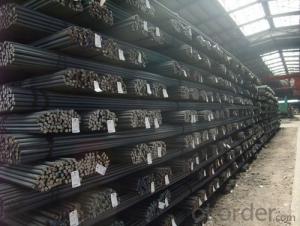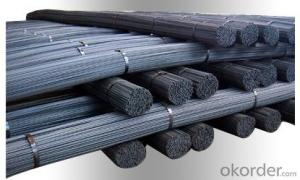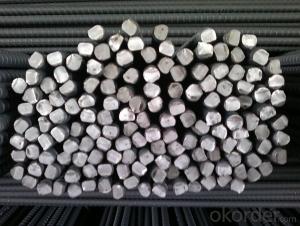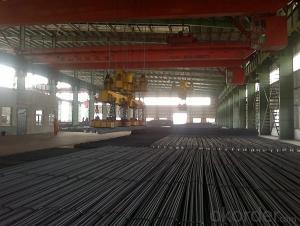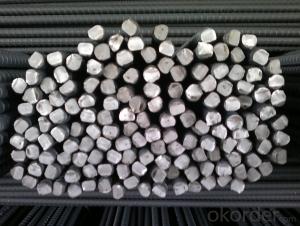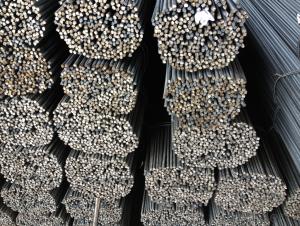Hot Rolled Deformed Steel Rebars for Buildings GB Standard
- Loading Port:
- Guangzhou
- Payment Terms:
- TT OR LC
- Min Order Qty:
- 25 m.t.
- Supply Capability:
- 200000 m.t./month
OKorder Service Pledge
OKorder Financial Service
You Might Also Like
Product Description:
OKorder is offering Hot Rolled Deformed Steel Rebars for Buildings GB Standard at great prices with worldwide shipping. Our supplier is a world-class manufacturer of steel, with our products utilized the world over. OKorder annually supplies products to European, North American and Asian markets. We provide quotations within 24 hours of receiving an inquiry and guarantee competitive prices.
Product Applications:
Hot Rolled Deformed Steel Rebars for Buildings GB Standard are ideal for structural applications and are widely used in the construction of buildings and bridges, and the manufacturing, petrochemical, and transportation industries.
1. Supporting members, most commonly in the house raising industry to strengthen timber bears under houses. Transmission line towers, etc
2. Prefabricated structure
3. Medium scale bridges
4. It is widely used in various building structures and engineering structures such as roof beams, bridges, transmission towers, hoisting machinery and transport machinery, ships, industrial furnaces, reaction tower, container frame and warehouse etc.
Product Advantages:
Hot Rolled Deformed Steel Rebars for Buildings GB Standard are durable, strong, and resist corrosion. And they are made of steel billets of high quality of China.
Main Product Features:
· Premium quality
· Prompt delivery & seaworthy packing (30 days after receiving deposit)
· Corrosion resistance
· Can be recycled and reused
· Mill test certification
· Professional Service
· Competitive pricing
Product Specifications:
Our supplier is a world-class manufacturer of steel, with our products utilized the world over. OKorder annually supplies products to European, North American and Asian markets. We provide quotations within 24 hours of receiving an inquiry and guarantee competitive prices.
Product Specifications:
Specifications of Hot Rolled Deformed Steel Rebars for Buildings GB Standard:
Standard | GB UK USA | HRB335 HRB400 HRB500 G460B, B500A, B500B,B500C GR40, GR60 | |
Diameter | 6mm,8mm,10mm,12mm,14mm,16mm,18mm,20mm, 22mm,25mm,28mm,32mm,36mm,40mm,50mm | ||
Length | 6M, 9M,12M or as required | ||
Packing | Export standard packing: wrapped by wire rod in bundles | ||
Each bundle weight | 2-3MT, or as required | ||
Trade terms | FOB, CFR, CIF | ||
Payment terms | TT payment in advance or Irrevocable LC at sight. | ||
Delivery Detail | within 45 days after received advanced payment or LC. | ||
Brand name | DRAGON | ||
Theoretical weight and section area of each diameter as below for your information:
Diameter(mm) | Section area (mm²) | Mass(kg/m) | Weight of 12m (kg) | Pcs/ton |
6 | 28.27 | 0.222 | 2.664 | 375.38 |
8 | 50.27 | 0.395 | 4.74 | 210.97 |
10 | 78.54 | 0.617 | 7.404 | 135.06 |
12 | 113.1 | 0.888 | 10.656 | 93.84 |
14 | 153.9 | 1.21 | 14.52 | 68.87 |
16 | 201.1 | 1.58 | 18.96 | 52.74 |
18 | 254.5 | 2.00 | 24 | 41.67 |
20 | 314.2 | 2.47 | 29.64 | 33.74 |
22 | 380.1 | 2.98 | 35.76 | 27.96 |
25 | 490.9 | 3.85 | 46.2 | 21.65 |
28 | 615.8 | 4.83 | 57.96 | 17.25 |
32 | 804.2 | 6.31 | 75.72 | 13.21 |
36 | 1018 | 7.99 | 98.88 | 10.43 |
40 | 1257 | 9.87 | 118.44 | 8.44 |
50 | 1964 | 15.42 | 185.04 | 5.40 |
Chemical Composition: (Please kindly find our chemistry of our material based on JIS as below for your information)
JISG3112 SD390 | Chemical Composition | ||||
C | Mn | Si | S | P | |
0.22 | 1.38 | 0.4 | 0.014 | 0.022 | |
Physical capability | |||||
Yield Strength(N/cm²) | Tensile Strength(N/cm²) | Elongation (%) | |||
620 | ≥400 | 21 | |||
The production process of Steel Rebar

1-Waling beam furnace 2-Roughing rolling group 3-Intermediate rolling train
4-Finishing rolling group 5-Water-cooling device 6-Walking beam cooler
7-Finishing equipment(including the cold scale shear,short feet collection system,
automatic counting device,bundling machine, collect bench)
Usage and Applications of Hot Rolled Deformed Steel Rebars for Buildings GB Standard:
Hot Rolled Deformed Steel Rebars for Buildings GB Standard is widely used in buildings, bridges, roads and other engineering construction. Big to highways, railways, bridges, culverts, tunnels, public facilities such as flood control, dam, small to housing construction, beam, column, wall and the foundation of the plate, deformed bar is an integral structure material. With the development of world economy and the vigorous development of infrastructure construction, real estate, the demand for deformed bar will be larger and larger..
Packaging & Delivery of Hot Rolled Deformed Steel Rebars for Buildings GB Standard:
Packaging Detail: products are packed in bundle and then shipped by container or bulk vessel, deformed bar is usually naked strapping delivery, when storing, please pay attention to moisture proof. The performance of rust will produce adverse effect.
Price: Keep lower operating costs so as to offer competitive price for our clients
Deformed Steel Rebars according to Korean standard
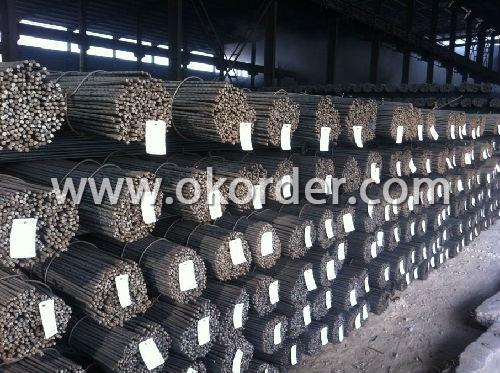

FAQ:
Q1: Why buy Materials & Equipment from OKorder.com?
A1: All products offered byOKorder.com are carefully selected from China's most reliable manufacturing enterprises. Through its ISO certifications, OKorder.com adheres to the highest standards and a commitment to supply chain safety and customer satisfaction.
Q2: How do we guarantee the quality of our products?
A2: We have established an advanced quality management system which conducts strict quality tests at every step, from raw materials to the final product. At the same time, we provide extensive follow-up service assurances as required.
Q3: How soon can we receive the product after purchase?
A3: Within three days of placing an order, we will begin production. The specific shipping date is dependent upon international and government factors, but is typically 7 to 10 workdays.
- Q: Can steel rebars be bent on-site to fit specific shapes?
- Yes, steel rebars can be bent on-site to fit specific shapes.
- Q: How heavy can a 25 mm thread steel bear?
- Steel is known as hot rolled ribbed bar. Ordinary hot rolled steel bars are made up of HRB and the minimum yield point of the brand. H, R, and B are the first letters in English for hot-rolled (Hotrolled), ribbed (Ribbed) and reinforced (Bars) three words.
- Q: How are steel rebars stored on-site?
- Steel rebars are typically stored on-site in a horizontal position, either on racks or on elevated platforms, to prevent contact with the ground and minimize the risk of corrosion. They are often organized by size and type, and protected from the elements through the use of waterproof covers or tarps. Additionally, rebars should be kept away from moisture and excessive heat to maintain their structural integrity.
- Q: Are steel rebars suitable for use in industrial structures?
- Yes, steel rebars are suitable for use in industrial structures. Steel rebars, also known as reinforcing bars, are commonly used in the construction industry to provide added strength and stability to concrete structures. They are made from high-strength steel and have excellent tensile strength, making them ideal for reinforcing concrete in industrial structures that are subject to heavy loads, vibrations, or other dynamic forces. Steel rebars also have good ductility and can withstand bending without breaking, which is important in industrial structures where high structural integrity is required. Additionally, steel rebars have good resistance to corrosion, which is essential in industrial environments where exposure to moisture, chemicals, or other corrosive agents is common. Overall, steel rebars are a reliable and durable choice for reinforcing industrial structures, ensuring their long-term structural stability and safety.
- Q: Are steel rebars fire resistant?
- Yes, steel rebars are generally considered to be fire resistant. Steel is an incombustible material, meaning it does not burn or contribute to the spread of fire. In the case of fire, steel rebars can withstand high temperatures for an extended period without losing their structural integrity. This is due to the high melting point of steel, which is around 1370 degrees Celsius (2500 degrees Fahrenheit). Additionally, steel rebars are often encased in concrete during construction, providing an additional layer of protection against fire. However, it is worth noting that in extremely intense and prolonged fire conditions, steel can eventually weaken and lose its load-bearing capacity. Therefore, fire protection measures such as fire-resistant coatings or fireproofing materials are sometimes applied to further enhance the fire resistance of steel structures.
- Q: What are the properties of steel rebars?
- Steel rebars, also known as steel reinforcing bars, possess several important properties. Firstly, they have high tensile strength, making them capable of withstanding heavy loads and stresses without breaking or bending easily. Secondly, they have excellent durability and resistance to corrosion, which ensures their long-term structural integrity. Moreover, steel rebars exhibit good thermal conductivity, allowing them to dissipate heat efficiently in high-temperature environments. Additionally, they are malleable and can be easily bent or shaped to fit different construction needs. Lastly, steel rebars have excellent bond strength with concrete, enabling the efficient transfer of loads between the two materials in reinforced concrete structures.
- Q: Can steel rebars be used in heritage building restoration?
- Yes, steel rebars can be used in heritage building restoration. They are commonly used to reinforce and strengthen the structural integrity of old buildings, helping to preserve their historical significance and ensure their longevity.
- Q: Are steel rebars suitable for reinforcement in historical monuments?
- Steel rebars can be suitable for reinforcement in historical monuments, as they are strong, durable, and provide structural stability. However, it is important to consider the specific requirements and conditions of each monument, as their use can potentially impact the historical integrity and aesthetic value. It is crucial to consult with experts in conservation and restoration to ensure the proper and sensitive use of steel rebars in historical monument reinforcement.
- Q: What is the process of pre-stressing steel rebars?
- The process of pre-stressing steel rebars involves applying a predetermined amount of stress or force to the rebar before it is placed in concrete. This is typically done by stretching the rebar using hydraulic jacks or other mechanical means. The purpose of pre-stressing is to introduce a compressive force in the rebar, which helps counteract the tensile forces that the concrete will exert on the structure. This technique enhances the strength and durability of the concrete structure, making it more resistant to cracking and deformation under load.
- Q: How are steel rebars used in the construction of dams?
- Steel rebars are used in the construction of dams to reinforce the concrete structure and provide additional strength and durability. They are typically placed within the concrete to resist tensile forces and prevent cracking or collapsing under the immense pressure of water. The rebars help to distribute the load evenly across the dam, increasing its overall stability and ensuring its long-term structural integrity.
Send your message to us
Hot Rolled Deformed Steel Rebars for Buildings GB Standard
- Loading Port:
- Guangzhou
- Payment Terms:
- TT OR LC
- Min Order Qty:
- 25 m.t.
- Supply Capability:
- 200000 m.t./month
OKorder Service Pledge
OKorder Financial Service
Similar products
Hot products
Hot Searches
Related keywords










